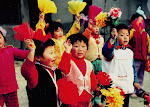 |
| A Chinese meal served in Beijing |
Honest. Not only that, but the waitress tried to convince me
the peanuts were almonds after I pointed out the discrepancy to her. She
finally gave up and asked, “Well, just what is an almond anyway?” Then she
brought the cook out, and they had a conversation in Spanish, the gist of which
was that she never used almonds in her almond chicken, but only peanuts, and
that I should shut up and just eat it
that way. (They didn’t realize I understood Spanish). I did shut up, but I didn’t eat the combo
plate. I sent it back, but not only because of the “almond” chicken. The barbecued
pork was way undercooked and the “foo yums” looked more like thick slices of
deep-fried doo-doo than anything yummy. (I assume foo yums were supposed to be egg fu young, but you could've fooled me.
This is one of the dangers of eating Chinese food outside of
China. It just taste or look the same. That’s one of the reasons why I’ve taken
cooking classes on trips back to Beijing and then taught myself how to make
other dishes I enjoy in the Middle Kingdom.
Many visitors to China never get to experience “real”
Chinese food, usually because they’re afraid to eat any place but their hotel
restaurant, where food is designed to appeal to Western tastes. Small
neighborhood restaurants are the place to experience true Chinese food.
Picking out a neighborhood restaurant is easy. Just look for
one that’s crowded with Chinese during mealtimes. If there are few diners there
during what should be their busiest times, avoid the restaurant: The food
probably isn’t that good.
And don’t worry about not being able to read the Chinese
menu. Many restaurants have menus with English translations that are sure to
spark a laugh. More restaurants now have picture menus. So you only need point
to the picture. Still at a loss about
what to order? It’s perfectly OK to walk around the dining room, seeing what
others are eating, then indicate by pointing to the dish that this is what you
want, too.




No comments:
Post a Comment